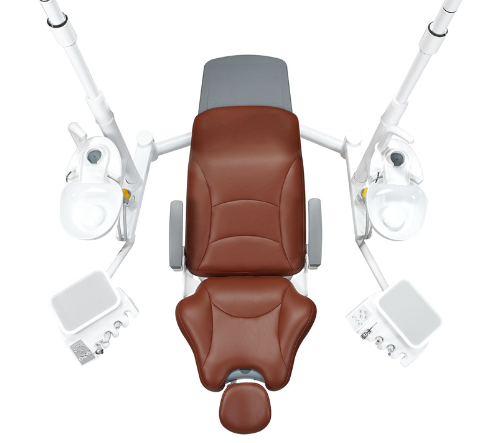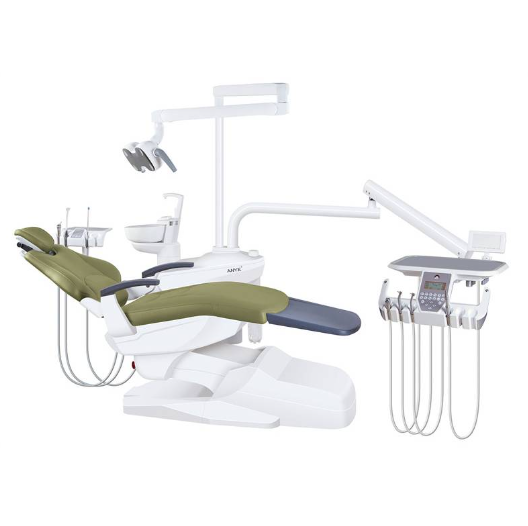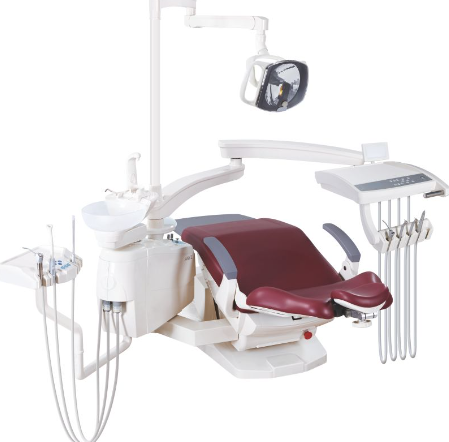Cómo elegir el mejor sillón dental automático: características clave a tener en cuenta
La piedra angular de cualquier consultorio dental reside en su equipamiento, en particular el sillón dental. Desde sus humildes comienzos manuales hasta las maravillas modernas de los sillones dentales automáticos, este equipo desempeña un papel fundamental en la atención al paciente y la eficiencia del médico. Además, las características del sillón dental también varían, lo que hace que la selección del mismo sea más complicada. En este artículo, el autor le guiará para elegir el sillón dental.
¿Qué es un sillón dental automático?
Los sillones dentales automáticos representan la evolución de la tecnología dental y ofrecen una sofisticada gama de funciones automatizadas diseñadas para mejorar la comodidad del paciente y agilizar los procedimientos dentales. A diferencia de sus homólogos manuales, estos sillones cuentan con funciones avanzadas y configuraciones personalizables.
Los sillones dentales vienen en varios tipos diseñados para distintos procedimientos, desde sillones de reconocimiento para controles de rutina hasta sillones quirúrgicos equipados para cirugías dentales complejas. Cada tipo ofrece funcionalidades específicas que atienden distintas necesidades dentales.
Los sillones dentales vienen en varios tipos diseñados para distintos procedimientos, desde sillones de reconocimiento para controles de rutina hasta sillones quirúrgicos equipados para cirugías dentales complejas. Cada tipo ofrece funcionalidades específicas que atienden distintas necesidades dentales.
Características clave a tener en cuenta al elegir un sillón dental automático
Para conseguir un sillón dental automático perfecto, es necesario tener en cuenta una serie de aspectos. En esta sección, el autor enumera las principales características que se deben tener en cuenta.
Ergonomía y comodidad del paciente
El énfasis en la ergonomía va más allá de la comodidad física; abarca la comodidad psicológica del paciente durante su visita al dentista. Características como el acolchado de espuma viscoelástica, los apoyabrazos ajustables y un diseño de silla que se adapta a distintas formas corporales contribuyen a crear un entorno relajante.
Además, factores como la capacidad de la silla para reducir los puntos de presión y la inclusión de elementos de calefacción o masaje pueden mejorar significativamente la comodidad del paciente, especialmente durante procedimientos más largos.
Además, factores como la capacidad de la silla para reducir los puntos de presión y la inclusión de elementos de calefacción o masaje pueden mejorar significativamente la comodidad del paciente, especialmente durante procedimientos más largos.
Movimientos y posiciones de la silla
Además de las funciones básicas de inclinación y reclinación, los sillones dentales avanzados ofrecen posiciones programables. Estos ajustes preestablecidos permiten a los dentistas ajustar rápidamente la configuración del sillón para procedimientos específicos o necesidades del paciente.
Las transiciones suaves entre posiciones, junto con un amplio rango de movimiento, garantizan un posicionamiento preciso sin causar molestias al paciente.
Las transiciones suaves entre posiciones, junto con un amplio rango de movimiento, garantizan un posicionamiento preciso sin causar molestias al paciente.
Sistemas de control e interfaz
La interfaz de control no solo debe ser intuitiva, sino también personalizable para adaptarse a las preferencias de cada profesional. Las pantallas táctiles o las interfaces de fácil navegación simplifican el manejo del sillón, lo que permite a los profesionales centrarse más en la atención al paciente.
La integración perfecta con instrumentos dentales, luces e incluso herramientas de imágenes digitales optimiza la funcionalidad del sillón y mejora la eficiencia del flujo de trabajo.
La integración perfecta con instrumentos dentales, luces e incluso herramientas de imágenes digitales optimiza la funcionalidad del sillón y mejora la eficiencia del flujo de trabajo.
Higiene y mantenimiento
Los materiales resistentes a las manchas, la corrosión y el desgaste son esenciales para mantener un entorno higiénico. Las superficies sin juntas y con mínimas grietas evitan la acumulación de residuos y hacen que la limpieza sea más sencilla.
Además, las sillas con componentes extraíbles y autoclavables, como reposacabezas o reposabrazos, garantizan una esterilización exhaustiva, reduciendo el riesgo de contaminación cruzada.
Además, las sillas con componentes extraíbles y autoclavables, como reposacabezas o reposabrazos, garantizan una esterilización exhaustiva, reduciendo el riesgo de contaminación cruzada.
Integración de tecnología
La capacidad de un sillón dental de integrarse sin problemas con herramientas de diagnóstico como cámaras intraorales o sistemas de rayos X es invaluable. Esta integración no solo agiliza el proceso de diagnóstico, sino que también mejora la eficiencia en el sillón.
Además, la compatibilidad con los registros médicos electrónicos (EHR) y el software de gestión de la práctica ayuda a organizar la información del paciente y los planes de tratamiento, promoviendo una práctica más conectada y eficiente.
Además, la compatibilidad con los registros médicos electrónicos (EHR) y el software de gestión de la práctica ayuda a organizar la información del paciente y los planes de tratamiento, promoviendo una práctica más conectada y eficiente.
Características de seguridad
Además de los mecanismos de parada de emergencia y las consideraciones de capacidad de peso, el diseño debe priorizar la estabilidad y el equilibrio. Características como un centro de gravedad bajo, una base resistente y medidas antivuelco garantizan que la silla permanezca segura incluso durante el movimiento del paciente.
Otras mejoras de seguridad, como sensores de colisión que evitan movimientos accidentales y sistemas de respuesta de emergencia automatizados, añaden capas de protección tanto para los pacientes como para los médicos.
Otras mejoras de seguridad, como sensores de colisión que evitan movimientos accidentales y sistemas de respuesta de emergencia automatizados, añaden capas de protección tanto para los pacientes como para los médicos.
Personalización y adaptabilidad
Un aspecto que a menudo se pasa por alto es la posibilidad de personalizar la silla para que se adapte a las necesidades específicas del paciente o a las preferencias del médico. Algunas sillas ofrecen componentes intercambiables o accesorios adicionales, como mesas con bandeja o reposabrazos, lo que permite la adaptabilidad a diferentes situaciones de tratamiento.
Los colores o patrones de tapicería personalizables también pueden contribuir a crear una atmósfera más acogedora en el consultorio dental.
Los colores o patrones de tapicería personalizables también pueden contribuir a crear una atmósfera más acogedora en el consultorio dental.
Conclusión
En general, los sillones dentales automáticos representan un avance significativo en la tecnología dental, revolucionando la experiencia del paciente y permitiendo a los dentistas realizar procedimientos de manera más eficiente mientras priorizan la comodidad y la seguridad del paciente.




Deja un comentario